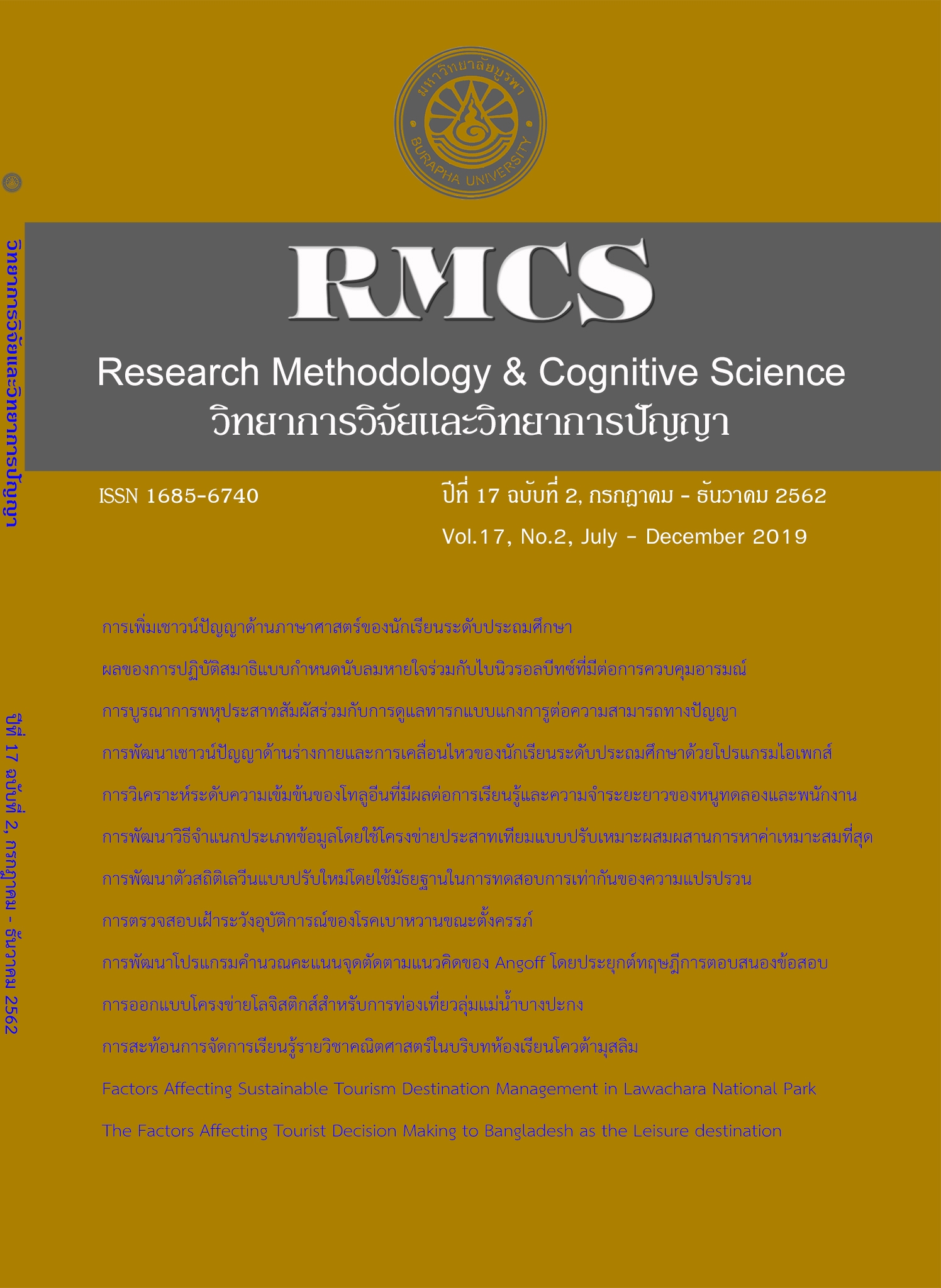Enhancing Bodily-Kinesthetic Intelligence among Primary School Students by IPEGs Program
Main Article Content
Abstract
The development of bodily-kinesthetic Intelligence is important to human life in the future because living in the future is at risk of chronic non-communicable diseases caused by sedentary behavior.The purposes of this study were to create IPEGs Programfor enhanceBodily-Kinesthetic Intelligence in Anubanjumphol Phonpisaiprimary school students. The process to development IPEGs program consisted of a review of literature, the design of the learning activity. There are three activities in IPEGs program (1) mental fitness training (2) physical fitness training and (3) relaxation. This program had been use for grade 5, 80 students, 4 experimental groups by comparing the mean scores of the correct answers from the Flanker Task intelligence test before and after the experiment. Data analysis using t-test and two-way ANOVA. The result show that mean score of accuracy from bodily-Kinesthetic Intelligence through computer of primary school students classified by gender and IQ level between before and after using the IPEGs program, there was a statistically significant difference at .01 level.In which males have higher IQ levels than females. In addition, high and low IQ levels interact with intelligence and physical movements. However, males and females do not interact with physical intelligence and movement, including sex and IQ levels do not interact with physical intelligence and movement of elementary school students. Statistical significance at the level of .01
Article Details
References
ปนิษฐา เรืองปัญญาวุฒิ. (2557). ผลของการจัดการเรียนรู้วิชาพลศึกษาโดยใช้เกมการละเล่นพื้นบ้านไทยที่มีต่อสุขสมรรถนะของนักเรียนประถมศึกษา. OJED, 9(2), 100-114.
สรวงสุดา มูลมา, รังสรรค์ สิงหเลิศ, ประวิทย์ สิมมาทัน และมโนรี อดทน. (2555). การศึกษาความสามารถในการใช้กล้ามเนื้อมัดใหญ่โดยใช้กิจกรรมการละเล่นพื้นบ้านของนักเรียนบกพร่องทางสติปัญญาระดับปฐมวัย. วารสารมหาวิทยาลัยราชภัฏมหาสารคาม, 2(2), 143-150.
สุพัตรา ตาลดี และสถาพร ขันโต. (2552). การศึกษาความสามารถทางพหุปัญญาของเด็กปฐมวัยโดยใช้กิจกรรมการละเล่นพื้นบ้าน. วารสารศึกษาศาสตร์ ฉบับวิจัยบัณฑิตศึกษา, 3(1), 1-5.
Ahamed, Y., MacDonald, H., Reed, K., Naylor, P. J., Liu-Ambrose, T., & Mckay, H. (2007). School-based physical activity does not compromise children's academic performance. Medicine & Science in Sports & Exercise, 39(2), 371-376.
Armstrong, T. (2018). Multiple Intelligences in the Classroom.(4th ed.). Alexandria, Virginia: Association for Supervision and Curriculum Development.
Bilir, F .P., & Sirin, Y. (2017). Analysis of bridge player profiles according to their intelligence areas. Journal of Education and Training Studies, 5(9), 100-108.
Carlson, S. A., Fulton, J. E., Lee, S. M., Maynard, L. M., Brown, D. R., & Dietz, W. H. (2008). Physical education and academic achievement in elementary school: Data from the early childhood longitudinal study. American Journal of Public Health, 98(4), 721-727.
Edmonds, W. A., & Kennedy, T. D. (2017). An applied guide to research designs: quantitative, qualitative, and mixed methods. (2nd ed.). Thousand Oks: SAGE Publications.
Dennis, T. A. (2010). Neurophysiological markers for child emotion regulation from the perspective of emotion–cognition integration: Current directions and future challenges. Developmental Neuropsychology, 35(2), 212-230.
El-Kholy, T., & Elsayed, E. (2015). Association of physicalactivity and health status with intelligence quotient of high school students in Jeddah. Journal of Physicaltherapy Science, 27(7),
2039-2043.
Gardner, H. (2011). Frames of mind: The theory of multiple intelligences. New York: Basic Books.
George, A. M., Rohr, L. E., & Byrne, J. (2016). Impact of Nintendo Wii Games on physical literacy in children: Motor skills, physical fitness, activity behaviors, and knowledge. Sports, 4(3), 1-10.
Kivunja, C. (2015). Creative engagement of digital learners with Gardner’s bodily-kinesthetic intelligence to enhance their critical thinking. Creative Education, 6(1), 612-622.
Mesa-Gresa, P., Gil-Gómez, H., Lozano-Quilis, J. A., & Gil-Gómez, J. A. (2018). Effectiveness of virtual reality for children and adolescents with Autism Spectrum Disorder: An evidence-based systematic review. Sensors (Basel, Switzerland), 18(8), 2486. doi:10.3390/s18082486
Mina, M., & Dusan, R. (2017). Level in which students prefer different types of Gardner’multiple intelligence. Journal of Educational and Instructional Studies in the World, 7(2), 55-64.
Perez, M. R., Nieto, P., Otero, R., Amengual, A., & Manzano, A. N. (2014). Relationships among multiple intelligences, motor performance and academic achievement in secondary school children. International Journal of Academic Research Part B, 6(6), 69-76.
Senel, E., & Yıldız, M. (2016). The investigation of bodily/kinesthetic intelligence and sports personship orientation of students in school of physical education and sport. International Refereed Academic Journal of Sports, Health and Medical Sciences, 19(1), 53-61.
Villiger, M., Liviero, J., Awai, L., Stoop, R., Pyk, P., Clijsen, R., ... & Bolliger, M. (2017). Home-based virtual reality-augmented training improves lower limb muscle strength, balance, and functional mobility following chronic incomplete spinal cord injury. Frontiers in Neurology, 8, 635.
Uzho, S. A., & Salame, P. M. (2016). Use of Bodily-Kinesthetic Intelligence Theory to Improve the Creative Learning of the English Language in Students of 1st EGB at Unidad Educative Bilingual Institution Particular Abdon Calderon. Guayaquil-Ecuador: United Educative instituteParticular Bilingual Abdon Caldero.

